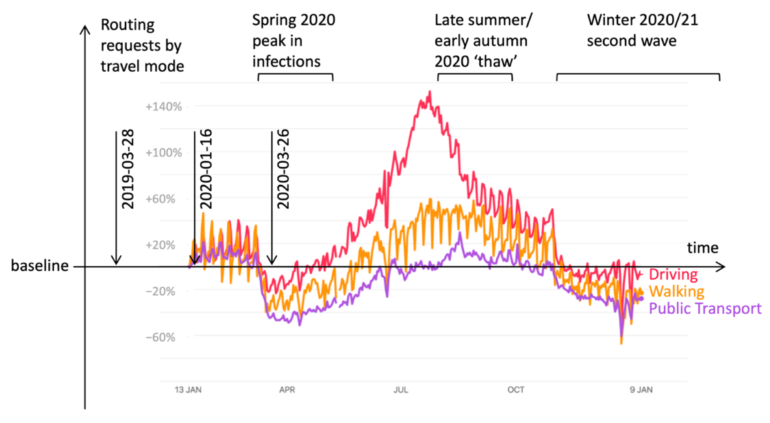The COVID-19 pandemic has reduced how often urban residents intersect with people from different income brackets, according to a new study led by MIT researchers.
Examining the movement of people in four U.S. cities before and after the onset of the pandemic, the study found a 15% to 30% decrease in the number of visits residents were making to areas that are socioeconomically different than their own. In turn, this has reduced people’s opportunities to interact with others from varied social and economic spheres.
“Income diversity of urban encounters decreased during the pandemic, and not just in the lockdown stages,” says Takahiro Yabe, a postdoc at the Media Lab and co-author of a newly published paper detailing the study’s results. “It decreased in the long term as well, after mobility patterns recovered.”
Indeed, the study found a large immediate drop-off in urban movement in the spring of 2020, when new policies temporarily shuttered many types of institutions and businesses in the U.S. and much of the world due to the emergence of the deadly COVID-19 virus. But even after such restrictions were lifted and the overall amount of urban movement approached pre-pandemic levels, movement patterns within cities have narrowed; people now visit fewer places.
“We see that changes like working from home, less exploration, more online shopping, all these behaviors add up,” says Esteban Moro, a research scientist at MIT’s Sociotechnical Systems Research Center (SSRC) and another of the paper’s co-authors. “Working from home is amazing and shopping online is great, but we are not seeing each other at the rates we were before.”
The paper, “Behavioral changes during the COVID-19 pandemic decreased income diversity of urban encounters,” was published in Nature Communications. The co-authors are Yabe; Bernardo García Bulle Bueno, a doctoral candidate at MIT’s Institute for Data, Systems, and Society (IDSS); Xiaowen Dong, an associate professor at Oxford University; Alex Pentland, professor of media arts and sciences at MIT and the Toshiba Professor at the Media Lab; and Moro, who is also an associate professor at the University Carlos III of Madrid.
A decline in exploration
To conduct the study, the researchers examined anonymized cellphone data from 1 million users over a three-year period, starting in early 2019, with data focused on four U.S. cities: Boston, Dallas, Los Angeles, and Seattle. The researchers recorded visits to 433,000 specific “point of interest” locations in those cities, corroborated in part with records from Infogroup’s U.S. Business Database, an annual census of company information.
The researchers used U.S. Census Bureau data to categorize the socioeconomic status of the people in the study, placing everyone into one of four income quartiles, based on the average income of the census block (a small area) in which they live. The scholars made the same income-level assessment for every census block in the four cities, then recorded instances in which someone spent from 10 minutes to four hours in a census block other than their own, to see how often people visited areas in different income quartiles.
Ultimately, the researchers found that by late 2021, the amount of urban movement overall was returning to pre-pandemic levels, but the scope of places residents were visiting had become more restricted.
Among other things, people made many fewer visits to museums, leisure venues, transport sites, and coffee shops. Visits to grocery stores remained fairly constant—but people tend not to leave their socioeconomic circles for grocery shopping.
“Early in the pandemic, people reduced their mobility radius significantly,” Yabe says. “By late 2021, that decrease flattened out, and the average dwell time people spent at places other than work and home recovered to pre-pandemic levels. What’s different is that exploration substantially decreased, around 5% to 10%. We also see less visitation to fun places.” He adds, “Museums are the most diverse places you can find, parks—they took the biggest hit during the pandemic. Places that are [more] segregated, like grocery stores, did not.”
Overall, Moro notes, “When we explore less, we go to places that are less diverse.”
Different cities, same pattern
Because the study encompassed four cities with different types of policies about reopening public sites and businesses during the pandemic, the researchers could also evaluate what impact public health policies had on urban movement. But even in these different settings, the same phenomenon emerged, with a narrower range of mobility occurring by late 2021.
“Despite the substantial differences in how cities dealt with COVID-19, the decrease in diversity and the behavioral changes were surprisingly similar across the four cities,” Yabe observes.
The researchers emphasize that these changes in urban movement can have long-term societal effects. Prior research has shown a significant association between a diversity of social connections and greater economic success for people in lower-income groups. And while some interactions between people in different income quartiles might be brief and transactional, the evidence suggests that, on aggregate, other more substantial connections have also been reduced. Additionally, the scholars note, the narrowing of experience can also weaken civic ties and valuable political connections.
“It’s creating an urban fabric that is actually more brittle, in the sense that we are less exposed to other people,” Moro says. “We don’t get to know other people in the city, and that is very important for policies and public opinion. We need to convince people that new policies and laws would be fair. And the only way to do that is to know other people’s needs. If we don’t see them around the city, that will be impossible.”
At the same time, Yabe adds, “I think there is a lot we can do from a policy standpoint to bring people back to places that used to be a lot more diverse.” The researchers are currently developing further studies related to cultural and public institutions, as well and transportation issues, to try to evaluate urban connectivity in additional detail.
“The quantity of our mobility has recovered,” Yabe says. “The quality has really changed, and we’re more segregated as a result.”
More information:
Takahiro Yabe et al, Behavioral changes during the COVID-19 pandemic decreased income diversity of urban encounters, Nature Communications (2023). DOI: 10.1038/s41467-023-37913-y
Provided by
Massachusetts Institute of Technology
This story is republished courtesy of MIT News (web.mit.edu/newsoffice/), a popular site that covers news about MIT research, innovation and teaching.
Citation:
Mobility-related data show the pandemic has limited the breadth of places people visit in cities (2023, April 28)



